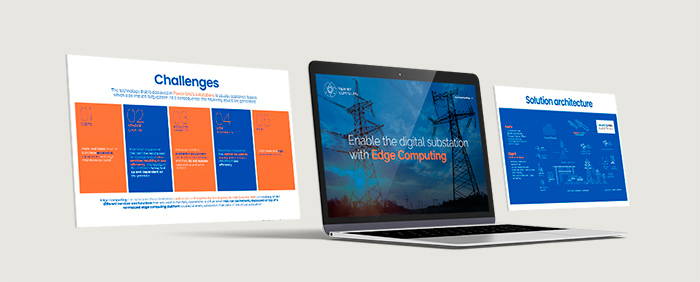CRITICAL INDUSTRY
Enabling the Virtual Digital Substation through Edge Computing
Challenges
The usual technology that is deployed in Power Grid substations to run and control critical service operations is frequently based on single-purpose appliances built and installed by vendors. This scheme implies some form of subjugation, and the following issues are on many occasions generated:
01
COSTS
As a result of their reduced bargaining capacity, TSOs and DSOs tend to pay higher CAPEX and OPEX to enable the Power Grid operation and control.
02
VENDOR LOCK-IN
This equipment’s IP is hold by each vendor and cannot be interconnected, resulting in low efficiency and “vendor lock-in” situations.
03
REDUCED VISIBILITY
Although certified, the substation equipment is normally delivered as black boxes, exposing limited operational or error metrics and with no potential tailored extension of their functionality.
04
LOW SCALABILITY
Operations (set-up, deployment, maintenance…) cannot be done in parallel to multiple nodes, many times not even remotely. New technology deployments of technology need to be done sequentially and may last up to years.
05
LONG INNOVATION CYCLES
To amortize the CAPEX and because of the very long innovation cycle, Power Grid operators plan for decades-long life cycles. This may potentially lead to miss out innovation opportunities enabling relevant benefits that cannot be leveraged until years later than available.
Edge Computing overcomes all the above limitations. By decoupling the SW from the HW, all services and functions become a virtual yet fully performant asset. These SW elements can be instantly deployed on top of small edge computing general-purpose HW platforms located at every substation and connected to a central automation platform.
Solution architecture
Assets
- 5G Spectrum* (n40)
- Satelite Constellation
- Transport Network (Fiber)
- Inspection Devices
- Employees hand devices
- ARVR Goggles.
Edge & Orchestration
- Massively distributed infrastructure
- Ad-hoc communications
- Macro and Micro – orchestration
- Multi-tenancy
- Use-case enablement – edge computing
Use Cases
Protection & Control Virtual Switch
-
Edge Computing brings the possibility to virtualize the “Protection and Control function” by making it a SW piece installed on top of regular servers, instead of being delivered through an appliance as in legacy systems.
-
The SW application reads incoming data from powerline sensors and applies a permanent decision algorithm, producing a signal to execute a physical circuit break if needed.
-
Low-level resource orchestration is responsible for securing that low-level compute resources (CPU threads, cache memory, NIC bandwitdth) will always be available to enforce a response in less than 2ms with full guarantee and other operation norms.
-
Replacing appliances by a pure-SW solution running on top of general-purpose servers triggers critical economic and operational benefits. This SW can coexist with other apps without compromising its performance.
Centralized Observation & Lifecycle Management
- The remote orchestration agents report constantly to a central console on the status of the servers and on the operations’ data, to predict potential service degrading or events.
- SW maintenance (upgrades, updates) is automated for a fast or programmed delivery across hundreds of substations in hours.
- The ability to distribute SW efficiently improves dramatically the capacity of the Power Grid to absorb available innovative features.
Local Wireless Networks (4G/5G) Management
- Deploying sensors or cameras in a substation requires a reliable wireless network.
- Orchestration facilitates the deployment, configuration and observation/maintenance of network radio and core functions, statically or dynamically, so networks can operate in unattended facilities with a low OPEX.
Edge AI Functions
- Incoming data from sensors can be processed locally by AI algorithms at high speed to spare compute power and storage at the Cloud level.
Remote Worker Assistance
- A key application for maintenance workers is Augmented Reality, which can in one hand deliver info of the existing power grid infra in real time, as well as facilitate the interaction from the field with expert supervisors sitting at their office desk.
- Augmented or Virtual reality apps must sit at the Edge Computing as they require low-latency, high bandwidth and low jitter.
Video Analytics Inspection
Several types of video analytics have been defined:
- Visual Inspection of power lines
- Partial Discharges
- Perimetral security
- Safety procedures’ compliance
Cameras may be placed on poles or on Automatic Guided Vehicles or Drones.
All of these applications can sit at the substation Edge Computing server. Orchestration will enforce their running conditions.
VALUE-ADDED solution
Outcomes
Edge Computing can overcome these limitations and create a disruption by decoupling the SW from the HW and making all the different services and functions that are used in the daily operations, a virtual asset that can be instantly deployed on top of a normalized edge computing platform located at every substation. Intel calls it “the virtual substation”.
Avoids Vendor Lock-in
Inherent Observability
The Edge Platform provides telemetry on a normalized format to be directly injected into the maintenance and support systems.
Breaking Down Data Silos
the Power Grid operator gets not only a common deployment model but enables a global data space to ensure reliable and secured planning, operation, and protection of the power grid.
-
- This is the only right architecture to deploy AI at the Edge.
- Accelerating the innovation cycle.
Lower CAPEX, Lower OPEX
Costs naturally decrease when using conventional HW and edge computing SW solutions.
Reliable Low Latency Performance
Reliable low latency performance even in shared compute environments thanks to Custom Provisioning Profiles that Create provisioning profiles tailored for each specific use case.

Enable the digital substation with Edge Computing.



